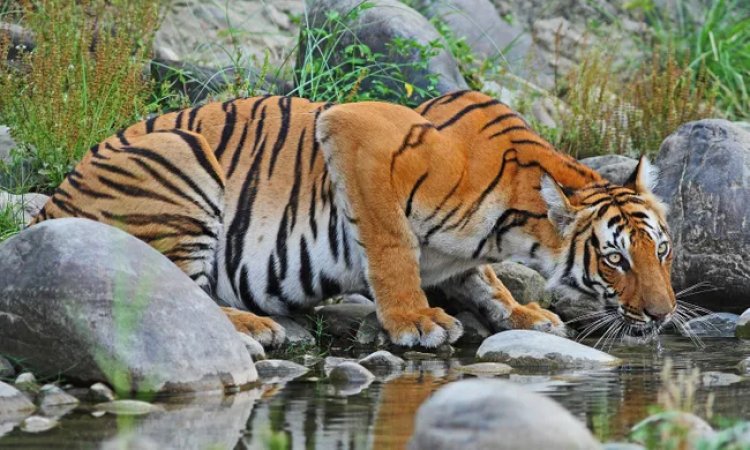Discovering the Rich Wildlife of Nepal: A Journey into the Heart of Nature
Embark on a journey to explore the diverse and abundant wildlife of Nepal. From majestic tigers to rare birds, discover the heart of nature in this captivating adventure.

Nepal is home to a rich and diverse wildlife, with over 800 species of birds and more than 200 species of mammals. From the towering peaks of the Himalayas to the lush forests of the Terai, the country is a natural paradise for wildlife enthusiasts and nature lovers. In this article, we'll explore the unique wildlife of Nepal, the role of protected areas in conserving its biodiversity, and the opportunities for wildlife watching and trekking in the country.
-
Overview of Nepal's Wildlife and Biodiversity
Nepal is located at the crossroads of three major biogeographic regions – the Himalayas, the Indo-Gangetic Plain, and the Plateau of Tibet – and as a result, it is a hub of biodiversity. The country is home to a wide range of habitats, from subtropical forests to high-altitude grasslands, and is a sanctuary for many species of birds and mammals. Some of the most iconic wildlife species found in Nepal include the Bengal tiger, Asian elephant, one-horned rhinoceros, and snow leopard.
-
Endemic Species of Nepal and their Habitats
In addition to its rich variety of wildlife, Nepal is also home to several species that are found nowhere else in the world. Some of these Endemic Species includes:
-
Snow Leopard (Uncia uncia):
Found in the high-altitude Himalayan regions of Nepal, the snow leopard is an endangered species that inhabits the rugged terrain of the Himalayas. -
Red Panda (Ailurus fulgens):
This adorable species is found in the temperate forests of eastern Nepal and is known for its distinctive red and black fur. -
Himalayan Tahr (Hemitragus jemlahicus):
Found in the high-altitude regions of the Himalayas, the Himalayan Tahr is a species of wild goat that is well adapted to the rugged terrain and cold climate of the region. -
Musk Deer (Moschus chrysogaster):
Found in the forests of the eastern and central regions of Nepal, the musk deer is a shy species that is known for its unique musk glands. -
Himalayan Black Bear (Ursus thibetanus):
Found in the forests of the eastern and central regions of Nepal, the Himalayan Black Bear is a powerful species that is known for its distinctive black fur and long claws. -
Bengal Fox (Vulpes bengalensis):
Found in the grasslands and scrub forests of the Terai region of Nepal, the Bengal fox is a small species of fox that is known for its adaptability and versatility. -
Langur Monkeys (Semnopithecus):
Found in the forests of the eastern and central regions of Nepal, Langur monkeys are a group of primates that are known for their distinctive black and white fur and long tails. -
Pangolins (Manis spp):
Found in the forests of the Terai region of Nepal, pangolins are a group of scaly mammals that are known for their unique armor-like scales.
Each of these endemic species has its own unique habitat requirements, ranging from high-altitude mountain habitats to lowland forests. To protect and conserve these species, it is important to conserve and protect the habitats that they depend on, such as forests, grasslands, and other natural areas.
-
The Role of Protected Areas in Conserving Nepal's Wildlife
Nepal has established a number of protected areas to conserve its wildlife and biodiversity. These areas, including national parks and wildlife reserves, are home to many of the country's most important species and habitats. Some roles of Protected Areas in Conserving Nepal's Wildlife are:
-
Conservation of Species and Habitats:
Protected areas play a critical role in conserving Nepal's unique and diverse wildlife by providing habitat protection, minimizing human impact, and reducing the threat of poaching. -
Management of Ecological Processes:
Protected areas also play a key role in managing and maintaining the natural ecological processes that are essential to the survival and health of wildlife populations and their habitats. -
Support for Sustainable Tourism:
Protected areas provide an opportunity for sustainable tourism that supports local communities and provides economic benefits while also conserving wildlife and habitats. -
Promotion of Education and Awareness:
Protected areas are also an important platform for promoting education and awareness about the importance of wildlife and conservation. This can include education programs for local communities, schools, and visitors, as well as public outreach and awareness campaigns. -
Partnership Building and Collaboration:
Protected areas can also help to build partnerships and collaboration between different stakeholders, including government agencies, local communities, NGOs, and private sector organizations. These partnerships can help to support conservation efforts and address challenges to wildlife and habitat protection. -
Monitoring and Research:
Protected areas also provide opportunities for monitoring and research that can help to inform conservation efforts and improve our understanding of wildlife and habitats.
These are some of the roles we can play to protect and conserve Nepal's wildlife areas.
-
Threats to Nepal's Wildlife and Conservation Efforts
Despite its rich wildlife and protected areas, Nepal faces a number of threats to its biodiversity. These threats includes:
-
Habitat Destruction and Degradation:
One of the biggest threats to Nepal's wildlife is the loss and degradation of their habitats due to human activities such as deforestation, land conversion, and development. This can lead to reduced habitat quality, fragmentation, and decreased wildlife populations. -
Poaching and Illegal Wildlife Trade:
Another major threat to Nepal's wildlife is poaching, both for commercial purposes, such as the trade in ivory, and for traditional medicine or other cultural practices. -
Climate Change:
Climate change is also a growing threat to Nepal's wildlife, as it can alter habitat conditions and disrupt migration patterns, feeding habits, and breeding cycles. -
Conflicts with Local Communities:
Conflicts between wildlife and local communities can also pose a threat to wildlife populations. For example, crop raiding by wild elephants and other wildlife can lead to human-wildlife conflicts and negative attitudes towards wildlife conservation. -
Lack of Funding and Resources:
Conservation efforts in Nepal can also be hindered by a lack of funding and resources, making it difficult to implement effective conservation and management measures. -
Weak Enforcement of Conservation Laws:
Weak enforcement of conservation laws and regulations can also pose a challenge to wildlife conservation in Nepal, as it can allow for illegal activities such as poaching to continue unchecked.
To address these threats, conservation efforts in Nepal, we need to focus on a variety of measures, including habitat protection and restoration, anti-poaching and law enforcement, community-based conservation and conflict resolution, research and monitoring, and public awareness and education. By working together and prioritizing conservation efforts, it is possible to protect and conserve Nepal's rich and diverse wildlife for future generations.
-
Trekking and Wildlife Watching Opportunities in Nepal
For wildlife enthusiasts and nature lovers, Nepal offers a wealth of opportunities for trekking and wildlife watching. Whether you're interested in exploring the high-altitude regions of the Himalayas or discovering the lush forests of the Terai, there's something for everyone in Nepal. Some of the trekking and wildlife opportunities in Nepal are:
-
Popular Trekking Destinations:
Nepal is home to many popular trekking destinations, such as the Annapurna Circuit, the Everest Base Camp Trek, and the Langtang Valley Trek, that offer stunning views of the Himalayas and opportunities for wildlife watching. -
Wildlife Sanctuaries and National Parks:
Nepal is also home to several wildlife sanctuaries and national parks, such as the Chitwan National Park and the Langtang National Park, that provide excellent opportunities for trekking and wildlife watching. -
Guided Tours and Trekking Expeditions:
There are many guided tours and trekking expeditions available in Nepal that are specifically designed to offer unique and immersive experiences for wildlife lovers. These can include jungle safaris, bird-watching tours, and nature walks. -
Local Communities and Culture:
Trekking in Nepal also provides an opportunity to experience the local communities and cultures that are an integral part of the country's rich and diverse heritage. -
Awe-Inspiring Scenery and Natural Beauty:
From the towering peaks of the Himalayas to the lush forests of the Terai, Nepal is a land of breathtaking scenery and natural beauty that is sure to captivate and inspire visitors.
Whether you are an avid trekker, a wildlife enthusiast, or simply someone who loves to immerse yourself in nature, Nepal offers a wealth of opportunities for exploring its rich and diverse wildlife. With its stunning scenery, rich culture, and abundance of wildlife, trekking in Nepal is an experience that is not to be missed.
-
Supporting Sustainable Tourism and Conservation in Nepal's Wildlife Habitats
As a visitor in Nepal, you can play an important role in supporting the country's wildlife and ecosystems. Some of these includes:
-
Economic Benefits:
Sustainable tourism in protected areas can provide economic benefits to local communities by generating income from visitor fees, local products, and other related activities. -
Employment Opportunities:
Sustainable tourism can also provide employment opportunities for local people, including guides, porters, and other support services. -
Community Involvement:
By involving local communities in the management and operation of protected areas, sustainable tourism can help to promote community ownership and responsibility for conservation efforts. -
Promotion of Culture and Heritage:
Sustainable tourism in protected areas can also help to promote and preserve local culture and heritage by highlighting the importance of traditional practices and values. -
Awareness and Education:
By providing visitors with opportunities to learn about wildlife and habitats, sustainable tourism can also help to raise awareness and understanding of conservation issues. -
Minimizing Environmental Impacts:
Sustainable tourism practices can help to minimize the environmental impacts of tourism on wildlife and habitats, such as reducing waste, controlling visitor numbers, and using sustainable transportation. -
Long-Term Conservation:
By supporting sustainable tourism and conservation efforts, we can ensure the long-term protection and preservation of Nepal's wildlife and habitats for future generations to enjoy.
By being mindful of our impact on the environment and supporting conservation efforts, we can help to ensure the long-term survival of Nepal's rich and diverse wildlife.
-
The Cultural Significance of Wildlife in Nepali Society
In Nepali culture, wildlife plays an important role in religious and cultural beliefs and practices. Some of the Cultural Significance of Wildlife in Nepali Society are:
-
Religious Significance:
Many species of wildlife in Nepal hold religious significance for the local communities and are revered as sacred or holy animals. For example, the cow is considered a sacred animal in Hinduism and is respected and protected by many communities in Nepal. -
Traditional Knowledge and Practices:
Wildlife in Nepal is also closely tied to traditional knowledge and practices, including local beliefs, customs, and rituals. For example, local communities may have traditional practices for hunting or harvesting wildlife that are rooted in their cultural heritage and beliefs. -
Livelihoods and Economic Benefits:
Wildlife in Nepal also plays an important role in the livelihoods and economies of local communities, including through hunting, fishing, and tourism. For example, the forests of Nepal are an important source of non-timber forest products for local communities, including medicinal plants, honey, and other wildlife products. -
Ecological Services:
Wildlife in Nepal also provides important ecological services, such as pollination, pest control, and seed dispersal, which support the health and productivity of the ecosystem. -
Aesthetic and Recreational Value:
Wildlife in Nepal also has aesthetic and recreational value, providing opportunities for nature-based recreation, such as wildlife viewing and bird-watching, which can contribute to local economies and improve the quality of life for local communities.
Overall, wildlife in Nepal has a rich cultural significance, tied to traditional knowledge and practices, livelihoods and economies, ecological services, and aesthetic and recreational value. By valuing and protecting wildlife in Nepal, we can ensure that these species continue to play a critical role in the cultural, social, and economic life of the country, while also supporting the health and productivity of the ecosystem.
-
Tips for Responsible Wildlife Watching and Minimizing Impact on Habitats
When visiting Nepal's protected areas for wildlife watching, it's important to be mindful of your impact on the environment and to follow responsible eco-tourism practices. Some of the Tips for Responsible Wildlife Watching and Minimizing Impact on Habitats are:
-
Respect Wildlife:
Observe wildlife from a safe distance, and do not disturb their natural behaviors. Avoid making loud noises, throwing objects, or getting too close. -
Follow Regulations and Guidelines:
Follow any regulations and guidelines set by protected areas and wildlife reserves to ensure responsible wildlife watching and minimize impact on habitats. -
Use Binoculars and Spotting Scopes:
Use binoculars and spotting scopes to observe wildlife from a distance, rather than approaching them. This will reduce the disturbance to the animals and their habitats. -
Stay on Designated Trails:
When hiking in protected areas, stay on designated trails to minimize impact on wildlife and their habitats. Avoid cutting through sensitive areas and respect any signs or barriers that are in place. -
Reduce Litter and Trash:
Reduce litter and trash by properly disposing of waste in designated areas. Do not leave any food or litter behind, as this can attract wildlife and disrupt their natural behaviors. -
Avoid Using Flash Photography:
Avoid using flash photography when observing wildlife, as it can disturb the animals and their habitats. If you must take photos, use a flash only when necessary and avoid shining it directly at the animals. -
Be Mindful of Wildlife Migration Patterns:
Be mindful of wildlife migration patterns, and avoid visiting areas during times of high activity or migration. This will help to minimize impact on habitats and reduce disturbance to the animals. -
Support Conservation Efforts:
Support conservation efforts by purchasing products and services from responsible tourism operators that prioritize wildlife and habitat conservation.
By following these tips for responsible wildlife watching and minimizing impact on habitats, we can help to protect and conserve Nepal's rich and diverse wildlife, while also we can enjoy a responsible and sustainable wildlife watching experience.
-
Future Prospects for Conservation and Sustainable Management of Nepal's Wildlife
Nepal is facing a number of challenges to its wildlife and ecosystems, but with the right efforts and support, the country has the potential to conserve and protect its rich biodiversity for future generations. Some of the future Prospects for Conservation and Sustainable Management of Nepal's Wildlife are:
-
Continued Investment in Protected Areas:
To ensure the long-term survival of Nepal's wildlife, it will be important to continue investing in the protection and management of protected areas. This can include funding for park management, wildlife monitoring and research, and community outreach and education programs. -
Supporting Sustainable Tourism:
Supporting sustainable tourism in protected areas can provide a valuable source of income for local communities while also supporting conservation efforts. This can include the development of eco-tourism initiatives and the promotion of responsible tourism practices. -
Enhancing Community Involvement:
Engaging local communities in conservation efforts and providing economic benefits from wildlife tourism can help to ensure the long-term success of conservation efforts. This can include training programs for local guides and park management staff, as well as community-based conservation initiatives. -
Strengthening Law Enforcement:
Strengthening law enforcement efforts to combat wildlife trafficking, poaching, and other illegal activities will be critical to the success of conservation efforts. This can include increased monitoring and surveillance, as well as collaboration with international partners to combat illegal wildlife trade. -
Building Partnerships and Collaboration:
Building strong partnerships and collaboration between different stakeholders, including government agencies, NGOs, and private sector organizations, will be essential to the success of conservation efforts in Nepal. These partnerships can help to leverage resources, build capacity, and address shared conservation challenges. -
Promoting Education and Awareness:
Promoting education and awareness about the importance of wildlife and conservation will be critical to the long-term success of conservation efforts. This can include education programs for local communities, schools, and visitors, as well as public outreach and awareness campaigns.
In conclusion, Nepal is a natural paradise for wildlife enthusiasts and nature lovers, with a rich and diverse wildlife and a variety of habitats ranging from the towering peaks of the Himalayas to the lush forests of the Terai. Whether you're trekking in the country's protected areas, exploring its endemic species, or supporting its conservation initiatives, there's something for everyone in Nepal. So pack your bags, grab your binoculars, and discover the heart of nature in this amazing country.
What's Your Reaction?







































































































